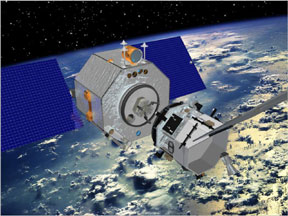
Orbital Express was a space mission managed by the United States Defense Advanced Research Projects Agency (DARPA) and a team led by engineers at NASA's Marshall Space Flight Center (MSFC). The Orbital Express program was aimed at developing "a safe and cost-effective approach to autonomously service satellites in orbit". The system consisted of two spacecraft: the ASTRO servicing satellite, and a prototype modular next-generation serviceable satellite; NEXTSat. The mission launched from Cape Canaveral Air Force Station on 8 March 2007, aboard an Atlas V expendable launch vehicle. The launch was part of the United States Air Force Space Test Program STP-1 mission.
NEXTSat, or Next Generation Satellite and Commodities Spacecraft (NEXTSat/CSC) is an American technology demonstration satellite which was operated as part of the Orbital Express programme. It was used as a target spacecraft for a demonstration of autonomous servicing and refueling operations performed by the ASTRO satellite. Launched in March 2007, it was operated for four months, and then deactivated in orbit.

USA-200, also known as NRO Launch 28 or NROL-28, is an American signals intelligence satellite, operated by the National Reconnaissance Office. Launched in 2008, it has been identified as the second satellite in a series known as Improved Trumpet, Advanced Trumpet, or Trumpet follow-on; a replacement for the earlier Trumpet series of satellites.

USA-212 was the first flight of the Boeing X-37B Orbital Test Vehicle 1, an American robotic vertical-takeoff, horizontal-landing (VTHL) spaceplane. It was launched aboard an Atlas V rocket from Cape Canaveral on 22 April 2010, and operated in low Earth orbit. Its designation is part of the USA series.
Samos 2 was an American reconnaissance satellite launched in 1961 as part of the Samos program. It was an early electro-optical reconnaissance spacecraft, meaning that it transmitted images to receiving stations on Earth rather than returning them in a film capsule. Samos 2 was a Samos-E1 spacecraft, based on an Agena-A.

Pegasus 1 or I, known before launch as Pegasus A, was an American satellite which was launched in 1965 to study micrometeoroid impacts in low Earth orbit. It was the first of three Pegasus satellites to be launched. The Pegasus spacecraft were manufactured by Fairchild Hiller, and operated by NASA.

Pegasus 2 or Pegasus II, known before launch as Pegasus B was an American satellite which was launched in 1965 to study micrometeoroid impacts in Low Earth orbit. It was the second of three Pegasus satellites to be launched, following the launch of Pegasus 1 three months earlier. The Pegasus spacecraft were manufactured by Fairchild Hiller, and operated by NASA.

Pegasus 3 or III, also known as Pegasus C before launch, was an American satellite which was launched in 1965 to study micrometeoroid impacts in Low Earth orbit. It was the last of three Pegasus satellites to be launched, the previous two having been launched earlier the same year. It was manufactured by Fairchild Hiller, and operated by NASA.
KySat-1 was an American satellite which was to have been operated by Kentucky Space. Designed to operate for eighteen to twenty four months, it was lost in a launch failure in March 2011 after the Taurus launch vehicle carrying it failed to achieve orbit.
USA-229, known before launch as NRO Launch 34 (NROL-34), is a pair of American signals intelligence satellites which were launched in 2011. They are operated by the United States National Reconnaissance Office.

USA-242, also known as GPS IIF-4, GPS IIF SV-5, Navstar-68 and Vega, is an American navigation satellite which was launched on 15 May 2013 and became operational on 21 June 2013. The fourth Block IIF GPS satellite, it forms part of the Global Positioning System.
OPS 5114, also known as Navstar 4, GPS I-4 and GPS SVN-4, was an American navigation satellite launched in 1978 as part of the Global Positioning System development programme. It was the fourth of eleven Block I GPS satellites to be launched.

TDRS-11, known before launch as TDRS-K, is an American communications satellite which is operated by NASA as part of the Tracking and Data Relay Satellite System. The eleventh Tracking and Data Relay Satellite is the first third-generation spacecraft.

Intelsat II F-1, also known as Blue Bird was a communications satellite operated by Intelsat. Launched in 1966 it was intended for operations in geostationary orbit over the Pacific Ocean to provide a communications link between Australia and the United States, however a malfunction prevented the satellite from reaching its planned orbit.
Intelsat III F-3 was a geostationary communications satellite operated by Intelsat. Launched in 1969 it was intended for operations over the Pacific Ocean; however, it spent most of its service life over the Indian Ocean at a longitude of 63 degrees east.

USA-248, also known as GPS IIF-5, GPS SVN-64 and NAVSTAR 69, is an American navigation satellite which forms part of the Global Positioning System. It was the fifth of twelve Block IIF satellites to be launched.

USA-256, also known as GPS IIF-7, GPS SVN-68 and NAVSTAR 71, is an American navigation satellite which forms part of the Global Positioning System. It was the seventh of twelve Block IIF satellites to be launched.

USA-258, also known as GPS IIF-8, GPS SVN-69 and NAVSTAR 72, is an American navigation satellite which forms part of the Global Positioning System. It was the eighth of twelve Block IIF satellites to be launched.

USA-262, also known as GPS IIF-10, GPS SVN-72 and NAVSTAR 74, is an American navigation satellite which forms part of the Global Positioning System. It was the tenth of twelve Block IIF satellites to be launched.

USA-265, also known as GPS IIF-11, GPS SVN-73 and NAVSTAR 75, is an American navigation satellite which forms part of the Global Positioning System. It was the eleventh of twelve Block IIF satellites to be launched.






